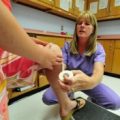
The first time I went to see my current dentist, they took my blood pressure. I had never had a dentist do that before. How unusual—I thought—I am just getting my teeth cleaned. So, I decided to talk to my hygienist about it. They said it is always the first thing they do when their patients sit in the exam chair. And as it turns out, there are many reasons why it’s a good idea to check a patient’s blood pressure—it is a health care appointment, after all! And, the connection of oral health to overall health is well-established. Unfortunately, the way we have set up our health care system has created a false distinction that separates our physical, oral, and behavioral health.
As holds true with physical and behavioral health, oral health disparities persist across race, with people of color experiencing worse oral health outcomes than their white counterparts, nationally and in Colorado. For example, preschool-age American Indian children in 2014 were four times more likely than white children to have untreated tooth decay. There is a growing recognition that oral health providers are an important part of the solution when it comes to addressing social determinants of health and working toward health equity. We have called on health care systems to make it easier for their patients to access care by co-locating services and addressing social determinants of health. Oral health is an essential piece of this puzzle.
There is work happening across the state for people to receive oral health care where they receive other services or attend school. For instance, Federally Qualified Health Centers all offer basic dental services for their patients, many of whom lack insurance or have Medicaid. Additionally, the Colorado Department of Public Health and Environment has created the Smart Mouths Smart Kids toolkit to support the development and implementation of oral health programs in schools. Since low-income children and children of color in Colorado have the most limited access to dental insurance and regular oral health care, this is an important way to improve oral health outcomes.
The factors that prevent people from going to the dentist or lead to poor oral health problems are, by and large, the same ones that limit access to physical health care: access to transportation, access to healthy foods, language barriers, and other social determinants of health. As we discussed in the report we published last year, there are many ways that health systems can work to understand and address the social determinants of health. Oral health providers and communities have the opportunity to do the same. Center for Health Care Strategies developed a technical assistance brief for communities to address the social determinants of oral health for low-income patients, highlighting case studies from across the nation.
When we break down the barriers that we’ve created in our health care system, we can uncover commonsense solutions to meet the oral, physical, and behavioral health needs of our families and communities. Are you due for a teeth cleaning and dental check-up? Make your appointment today, and ask your dentist how they’re thinking about their patients’ overall health and working toward health equity.




